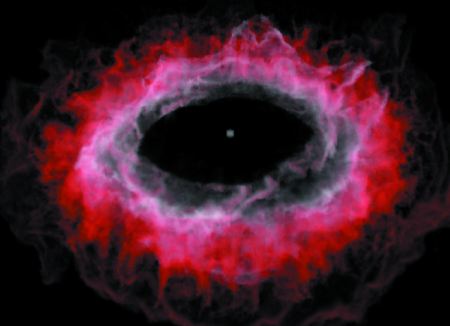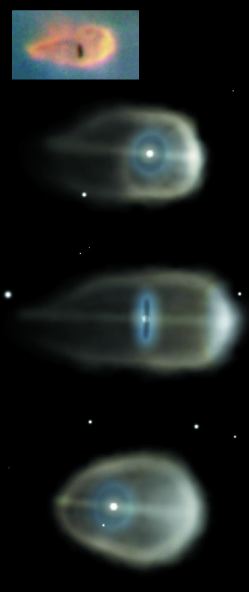

 Skip to navigation
Skip to navigation
Site Primary Navigation:
- About SDSC
- Services
- Support
- Research & Development
- Education & Training
- News & Events
Search The Site:

| SDSC RESEARCH | Contents | Next | |
Galactic MPIRE: Flying through the Digital Galaxy |
|
| FEATURED Dennis M. Davidson, Carter Emmart, Myles Gordon, James S. Sweitzer, Neil de Grasse Tyson, Erik Wesselak, American Museum of Natural History |
C.R. O'Dell, Zheng Wen, Rice University Jon Genetti, Greg Johnson, David R. Nadeau, Steve Napear, Allan Snavely, SDSC |
|
THE DIGITAL GALAXYTERA AND THE GALACTIC MPIREDESTINATION: ORION |
|
|
|
 |
|
Thisfrom a fly-by motion sequence rendered by Galactic MPIRE shows a wispy ring-shaped nebula cast off by a star evolving into a white dwarf. |
|
|
|
THE DIGITAL GALAXY"One of the new and most exciting technologies we will have is Trimension's all-dome digital video," said James Sweitzer, director of special projects for the Hayden Planetarium. "A normal planetarium star projector typically shows only that part of the universe we see with our unaided eyes from Earth--about 9,000 stars. But the known universe contains billions of galaxies, each containing billions upon billions of stars. With all-dome video, visitors can move all around the universe, as long as we can simulate it." The planetarium's Digital Dome system, custom-built by Trimension virtual reality systems, integrates seven SEOS projectors and a 28-processor SGI Onyx2 computer to display a composite image of 7.34 million pixels. The SGI Onyx2 renders visual simulations in real time and combines them with pre-rendered graphics. Aechelon Technology's C-Galaxy simulation software calculates interstellar perspective views of stars in the Milky Way from more than 100,000 nearby stars in the new Hipparcos database and more than two billion stars in a statistical database developed by the museum. "The result," reports Davidson, "is a breathtakingly realistic real-time rendering of billions of stars in our home galaxy." But a galaxy is more than just billions of stars. "The most beautiful, visually complex, and scientifically interesting destinations of the planetarium voyages are nebulas--immense clouds of dust and gas, some of which extend for dozens of light-years through interstellar space," said Dennis Davidson, project manager and creative director for the planetarium's Digital Galaxy project. A reflection nebula shines when the light of nearby stars (which typically have condensed from the substance of the nebula itself) reflects off countless particles of interstellar dust. An emission nebula glows because atoms of gas fluoresce when excited by ultraviolet radiation in starlight, in much the same way that some posters glow under a UV "black light." The dust in a dark nebula obscures objects behind it. "Many nebulas involve a mix of these effects, all three of which are impossible to simulate realistically in 3-D with traditional polygon-surface computer graphics methods," he added. |
Top| Contents | Next |
TERA AND THE GALACTIC MPIREIn 1998 and early 1999, SDSC showed that computer graphics can render realistic views of diffuse astronomical objects. The Massively Parallel Interactive Rendering Environment (MPIRE) visualization package creates images from 3-D data sets that divide the image volume into a matrix of individual volume elements (voxels). An image is defined by raycasting, traversing through the contents of the voxels that intersect each line of sight from the viewpoint. Since a volume with 1000 pixels on a side contains a billion voxels, a realistic 3-D image requires an extremely fast computer with a large memory to perform all of the calculations. "We had already demonstrated MPIRE's speed and versatility with the 32-gigabyte Visible Human dataset," said David Nadeau, the leader of SDSC's technical team working with the Hayden Planetarium. "But we had to create some unique enhancements to handle astronomical data." The enhancements give MPIRE Galaxy Renderer unique capabilities. They allow each voxel in the model to emit an individually variable amount of light with a specific color spectrum, and to absorb light in a beam passing through the voxel by a percentage that is independent of the emission. MPIRE also was extended to handle perspective views, essential for realistic fly-through simulations. MPIRE was first developed for distributed-memory massively parallel processor systems--such as the Cray T3E and IBM SP, but perspective volume- rendering is difficult and and time-consuming to parallelize on these machines. The solution was to run Galactic MPIRE on the Tera MTA, the new multi-threaded architecture supercomputer that SDSC has been evaluating for the NSF and DARPA. "The simple programming model of the MTA allows scientists to set up calculations in a straightforward, intuitive way," said SDSC computer scientist Allan Snavely. "For raycasting without perspective, the MTA outperforms the T3E and SP2 by a processor-to-processor ratio of four to one," said Greg Johnson, one of the authors of the code. "When perspective is added, the Tera's unique architectural features enable a significant leap in capability." The demonstration created two motion sequences, one of a wispy ring-shaped nebula cast off by a dying star (Figure 1), the other of a star with a chaotic, disturbed atmosphere. "Moving-perspective views of fuzzy objects present a nasty rendering problem," said Jon Genetti, the other author of MPIRE, "and the Hayden visualization experts were skeptical that anyone could make realistic movies. We managed to surprise them." |
Top| Contents | Next |
|
|
|
Figure 3. Closeup of a Proplyd.
The image at the top shows HST10, a protostar in the Orion Nebula surrounded by a cocoon of dust and gas distorted into a teardrop shape by interstellar winds and radiation from nearby hot stars. Inside the teardrop, a disk of dark protoplanetary material roughly the size of our solar system orbits the star. (Credit: C.R. O'Dell and NASA.) The other images, rendered by David Nadeau using Galactic MPIRE, depict a model of HST10 from viewpoints left of, beside, and right of the proplyd. |
 |
|
|
|
DESTINATION: ORIONThe primary destination of the first planetarium voyage is an ambitious challenge for the visualization team--a fly-through of the Orion Nebula (see the back cover). Two dozen light-years across and 1500 light-years away, the Orion Nebula is a region of dense clouds of gas and dust. Embedded within the clouds is a cluster of very young stars, less than a million years old, that illuminate the dust and energize the gas into fluorescence. Stellar winds and radiation pressure from the hot, young stars roil the gas and dust into opaque knots and condensations. "One of our big challenges is to create a library of digital models of astronomical objects that re-create the visible universe," Sweitzer said. "To do this, we translate information from the Hubble Space Telescope and several ground-based sky surveys into data sets. NASA support for the Digital Galaxy project has been very generous." The Hayden visualization team has enlisted the aid of C.R. O'Dell of Rice University, one of the world's foremost authorities on the Orion Nebula. Working with infrared and visible light observations from Hubble and ground-based observatories, O'Dell and his former graduate student Zheng Wen have pieced together a 3-D model of this fascinating volume of space, and also have provided images corrected to remove the reddening and obscuring effects of interstellar dust. Renowned astronomical artist Carter Emmart is the Digital Galaxy project's manager for science visualization. He and programmer Erik Wesselak combine polygonal spatial models and image data in a texture-mapping process (Figure 2), and define the flight path and viewing parameters of the fly-through simulation. Then Nadeau runs a visualization toolkit that includes a "scene construction tool" that converts the polygonal model to 3-D voxel data and perturbs the smooth (and unrealistic) surfaces of the model into more realistic cloudy structures that can be fuzzy, wispy, or blotchy depending on the degree of disturbance. The Orion Nebula sequence--two minutes of high-resolution animation on seven independent projectors--then is rendered by Galactic MPIRE as more than 25,000 separate images occupying more than 100 gigabytes of digital storage. Observations in infrared light (which is less absorbed by dust than visible light) reveal stars inside the nebula still in the process of formation. Wrapped in cocoons of the dust and gas from which they condensed, these protostars often are orbited by disks of debris that astronomers believe are the sign of new planetary systems in the making. These protoplanetary disks (proplyds) are one of O'Dell's specialties, and he was particularly interested in how they would look in the visual simulation. The original plans called for SDSC to model three proplyds in the nebula, but the visualizations turned out so well (Figure 3) that the scenario was revised to include more than 80 proplyds, and the flight plan now calls for a close flyby of one of these nascent planetary systems. "This data will be understood by millions of people because of the cooperative effort of the American Museum of Natural History, SDSC, and NASA with the guidance of Bob O'Dell, the world's leading expert on Orion," Emmart said. "We see this as merely the opening act, with more to come." "It's good to know that our work will contribute to the success of the new Hayden Planetarium," Nadeau said. "Galactic MPIRE and the tools we've developed for scene construction are applicable to many other problems in scientific visualization, and we'll add them to NPACI's Scalable Visualization Toolkit when we're done so other people can use them." --MG * |
Top| Contents | Next |